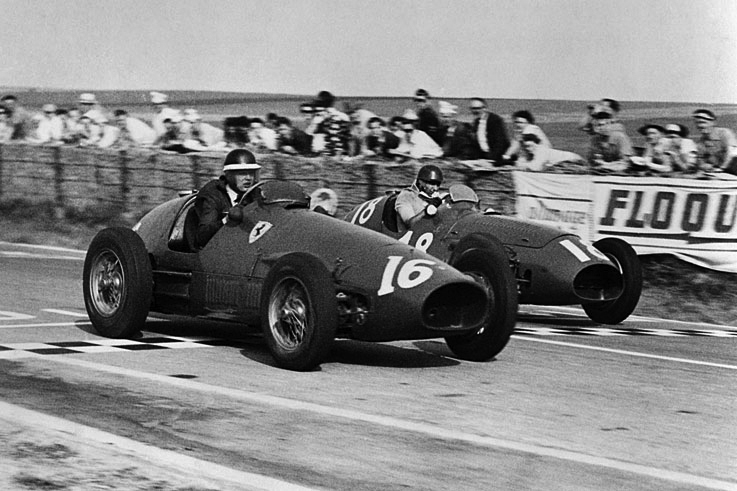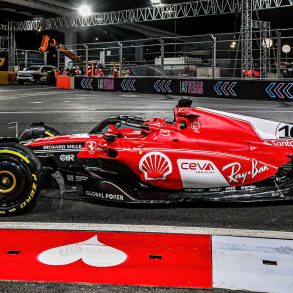1953 French Grand Prix – The New Boy Makes Good
By Rodney Walkerley
I find this a most difficult report to write. If I use the superlatives justified by the staggering racing we witnessed in the 40th Grand Prix de France this afternoon, a certain exaggeration might be suspected. But it can go on record that Mike Hawthorn’s magnificent victory by one second over the champion Fangio crowned a neck-and-neck, wheel-to-wheel duel for the last half of the race, with four seconds between 2nd and 3rd, and 3.2 seconds between 3rd and 4th, and gave the shouting spectators what is probably the finest Grand Prix ever run anywhere at any time, with what amounted to two dead heats in lightning succession.
The young British driver stood for the British National Anthem with tears of emotion running down his cheeks, while the crowd audibly gasped with amazement when he took off his helmet and they saw his obvious youth after a drive in which he matched even the champion on the circuit, with courage, speed and race craft.
The lap record went seven times-twice by Gonzales at just under 114 mph, once by Villoresi, once by Ascari, once by Farina, and twice by Fangio, who left it at 11.5.91 mph in his supreme effort to pass Hawthorn and stay in front. The race average started at 111. 9 mph and steadily went up to 113.65 at the finish, a variation of 1.75 mph.
In practice, Ascari’s Ferrari made best time in 2 min. 41.2 sec. (115.83 mph), with Gonzales second in 2 min. 41.5 sec. On this circuit the Ferraris found a little more speed to match the Maseratis. Ascari and Farina had modified radiators and oil radiators on their cars.

Gonzales cunningly started with half a tank full of fuel to save weight and add speed; he shot into the lead, followed by Ascari, Bonetto, Villoresi, Hawthorn, and led for 29 of 60 laps. Bonetto overdid a corner, and dropped back, and at 20 laps the order was Gonzales, crouching lower than ever, and already leading by 19 sec., Hawthorn, Ascari, Villoresi, Farina and Fangio. The three leading Ferraris raced in arrowhead formation, not two lengths apart, but changing their order lap after lap. At 21 laps Fangio slammed past Farina in fifth place and was in among the Ferraris. All six were racing almost in line fractions of a second apart, a desperate affair where one false move meant disaster. Five seconds covered the five cars – and on lap 26 Fangio passed Villoresi into 3rd place.
On lap 29 he passed Ascari into 2nd place, only 20 seconds behind Gonzales, and Gonzales dashed in for another half-tankful of fuel. Fangio was tanked like the Ferraris to run nonstop. Gonzales’ stop was of only 27 seconds, and in that brief period he was passed by five cars.
At 30 laps, halfway, the order was Fangio, Hawthorn, Ascari, Farina, Marimon, Gonzales, Villoresi, and well behind, Bonetto, de Graffenried, Behra and the rest, most of them already lapped more than once. The first three were all racing wheel-to-wheel and nose-to-tail, lap after lap, one second covering all three.
Then began the last half of this amazing race. Hawthorn and Fangio put up a demonstration, which took the breath away. Never more than one second apart, they spent most of their time racing abreast not more than two feet apart. Once Hawthorn used the grass, overtaking a slow car, to give Fangio room to stay alongside a courtesy not lost on the crowd. On laps 32, 33, 34 Hawthorn was in front perhaps a hood length.
On laps 35, 36 it was Fangio, then Hawthorn again for two laps, Fangio for two laps, Hawthorn for four laps – and so they raced side by side, now one, now the other, half a length in front.
The other cars were dropping out behind this battle of giants. Villoresi, with a rueful grin, moved out of it in the last few laps, stabbing his fingers at the fliers and shaking his head comically as he overtook Peter Collins.
I shall not attempt to describe the final laps. The whole thing was fantastic. The crowd was yelling, the commentators were screaming. Nobody paid much attention to the rest of the drivers at all, and the drivers themselves slowed up to watch this staggering display. From laps 54 to 58 Fangio led by a length, but both cars raced side by side, Hawthorn giving a corner after the pits each time, but, I suspect, carefully rehearsing his final spurt each time he drew level on the finishing straight. On lap 59 he did it, flashing past and holding his cornering, and on the final lap again they shot round nose-to-tail, and it was the Englishman who brought the Ferrari over the line. As Fangio flashed past, a second later, Gonzales almost caught him with Ascari a moment away; his rear wheels level with Gonzales’ tail.
Hawthorn’s ovation was like the roar one hears at the end of a great maestro’s concert – and today Hawthorn was a maestro.
1953 French Grand Prix Results
- J. Mike Hawthorn FerrariI (113.65 mph average)
- Juan Manuel Fangio Maserati
- Froilan Gonzales Maserati













